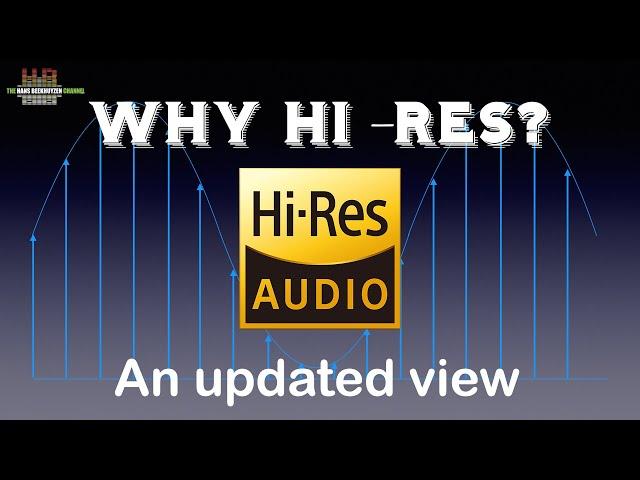
Why Hi res - an updated view
Комментарии:

If a human could be described as "reference", you Sir are it.
Ответить
I've heard God, no sarcasm. WOW!
Ответить
@hans, I would think 16 bits is 15*6dB dynamic range. 15 bits for the positive amplitude, 15 for the negative.
Ответить
Just watched this video (again) Hans.
My streaming solution is a Linn Klimax DS/Organik dac...using Qobuz or my own library I find various tracks sound equally as good at 44.1 kHz as @ 192 kHz 24 bit ...this upgraded in house designed dac was expensive @ £5,400 but it sounds superb!.

So, for me, what this means is that the AudioQuest Dragonfly Cobalt would be good enough for streaming from my PC, since I'm 67 years old and my upper limit hearing max's out at around 12000khz.... would that be correct? Greetings from Ontario Canada!
Ответить
Is bitperfect real? I listen to you and I begin to discover filters and manipulations even below my bed
Ответить
So is it wrong to think that a high res file has more density of information in the audible spectrum ? Because some people say high frequencies can be felt but not listened to and to me this is no sense
Ответить
Hello Hans, thank you very much!, I have a very quick question, my DAC only shows the sample rate without the bit depth of the file that it is processing, does this mean that it does not take into account if it is 16 or 24 bits?, or does it run with some calculation and modify the sample rate thats is showing?, thanks again.
Ответить
long story short...if you are NOT an audio geek (an audiophile doesn't count as audio geek because an audio geek actually knows how science and physics works) that knows how every record that plays is recorded and know how the signal path of the recorded instrument is processed and affects the sound until the master...stick to 44100 or 48000, no point to go higher than that, specially with music done, recorded and mastered entirely in the digital domain this days. Only reason to go higher is if you work with audio or dj where further audio processing and high SPL is applied....BUT in the other side if you are an audio geek that knows how to hear and knows how the records are recorded, then will be easier to choose the right high sampling rate audio that will sound VERY good in the giving listening system and strike...AUDIO NIRVANA!!!
Ответить
Thank u 😊
Ответить
I like my tda1541
Ответить
Great explanation, though I may have not understood everything you said. Does that mean that if I rip a cd and the software would oversample properly lets say to 96KHz that the result should be superior to a CD on a normal CD player? Software doesn’t require an expensive chip, it may require computing power. Thats no more a problem these days
Ответить
I prefer listening to 24/48 or 32bit DXD. Those two offer a good balance between the directional expanse and faded depth & cohesion of the sound image. 24/92 requires crossfeed to sound decent in my opinion, at least with headphones.
Ответить
Thanks for another great video Hans! I have recently come to the realization after many years of trying fancy oversampling and upsampling DAC’s, MQA decoders, 192khz etc that I actually prefer 16 bit 44.1 kHz especially if the music was originally mastered to sound good on CD. Just sounds more natural to my ears for long listening sessions.
I do like well recorded hi-res music, but most of the music that I enjoy was created before “hi res” was a thing.

This video confirms my own subjective experiences on hidef.
The 192khz on my M4 without doubt sounds better than any other sample rate and to my ears uncannily analogue.
This debate went on and on with other music making friends since the 90s with many citing the nyquist theorem as proof positive.
Only quite recently are my ears effectively fooled: early, 20/48 and 24/96 still had that digital feel.
Not now.
Come on MIDI2 and 3!
Thank you for another useful video.

It will always amaze me how far ahead and future proof the CD was in 1982. Not before the year 2000 did people have PCs in their home that could hold more than a handful of full quality CDs, and even then storage was at such a premium that we got this mess with mp3 that we are in. Meaning that most people make due now with quality audibly worse then CD, of not on their device, then what reaches their Bluetooth ear buds.
With SACD the industry completely botched it by pushing the hardware prices way too far out of consumers reach. You can't have the CD be the standard and then it's successor moves back to cutting edge prices that were asked in the early 80s. DVD and BluRay did it right, SA CD did not need to fail.
It's a real shame too, the mainstream consumer may never experience high res audio.

Thanks for the lucid explanations. The mechanism you explained in the latter part of the video on how a higher res music file can sound better on a DAC should be objectively testable since it's not a subjective perception but rather about a measurable loss in sound quality, right? There are many tests measuring how transparent are different DACs, and some of the cheap modern DACs do score very well. I also don't know how much of these differences are audible to an average listener.
Ответить
I disagree, my two ears much prefer higher bit! Its sounds fuller and better sound stage, dynamic and musicality ;)
Ответить
Thanks much for explaining something that i was struggling with the past year. Not understanding way 192 or 96 did not always sounder better than 44 KHz. Had already came to a conclusion 44 KHz sounded more balanced and had my preference ween recorded well
Ответить
I was hoping for some thoughts on DSD, I use a March DAC, anything below 88Khz PCM, I convert to DSD256, using Roon. I am more than happy with my aural experiences. DSD is coming very close to my LP sound quality, if not bettering it in some cases.
Ответить
Hello Hans, very interesting!
It's an intriguing subject to me because I've always struggled to hear the difference, even between a good bitrate AAC/Vorbis/Opus and a PCM file (though it is audible). I take it neither my ears or gear are good enough for these subtle details. I'm also aware of how psychologic factors can affect our hearing. Things tend to sound better when we think they will. That's why a lot of people prefer the sound of vinyl: even though it's objectively worse than even lossy formats used for streaming, a physical piece of music has stronger emotional affect on people (and we tend to get used to the nice distortion and frequency response it has).
Not to say I don't believe your experience, as your ears, knowledge and gear are obviously far superior to mine. But I'm curious if there has been tests conducted in a "blind" environment proving that Hi-res actually sounds better for some people.
Something else I'm thinking a lot about is the inefficiency of 24 bit when it comes to lossless compression. More and more streaming subscriptions give lossless as an option, and I think it's dumb to give 24 bit quality as a default. Lossless encoding struggles a lot more with 24 bit, resulting in often twice the bandwidth for no audible benefit (in my experience). Apple Music doesn't have an option to stream 16 bit and will always use the highest available bit depth, and I think it's just bad for accessibility, optimisation and carbon emissions.
I'd be very interested to know your thoughts about all of this!

I have a Qobuz subscription being used through a BluSound node. But I have streamed several newer albums from this service in quoted Hi Res audio. I admit my ears are probably not the best, but to me some of these didn’t sound as good/ great to similar at CD quality. I often put this down to way it was mixed. I have also tried so called Hi Res on albums originally recorded back in the 1970‘s and obviously to digitise it would have been re mastered definitely don’t sound great to my ears, rather just used CD’s quality on these…
Ответить
Hi Hans, awesome Video as always.
There are two things I find hard to follow:
1. You speak about the bad sound of steep filters, but then mostly about playback. But isn't the damage done on the recording side? As the steep filter has to be applied before the D-A process to avoid aliasing in the sampling process?
So how can oversampling in any (mega-ecpensive) dac fix that issue? Since the damage has already been done.
2. How does it take a super expensive dac to do oversampling properly? It should be a mathematically a rather simple process, that a modern CPU should be able to handle below 1% of load.
When I playback a CD file from my PC and the audio-link to the USB dac is set to 192kb/s isn't windows upsampling on the fly anyways?🤔
According to Shannon/Nyquist the Waveform of a CD file should be perfectly defined and adding in 3 more samples should really be a pretty trivial task for a computer in my humble opinion🤔. As far as I know, most DACs have a native Sampling rate anyways and all incoming signals are internally upsampled to that rate anyways, no?🤔
Just my two cents

Nice vid. I am stuck at 44.1 basically. None of my music will ever be recorded at hires. I have thought about upsampling the files in a computer and playing those files but what a time investment that would be for little gain. I have hardware that will do 192k but havent heard a big difference with upsampled files. Have an old dac that upsamples everything to 192k. I will hook it up and see if it makes a diff. But the new dac is probably better anyhow.
Ответить
I have done testing on my frequency response with my Topping E50 DAC and HifiMan Edition XS headphones that can reproduce sound in 8-50 000 Hz range with an online tone generator. I and my brother could hear around to 12 Hz and up to 23 KHz. We did repeated tests and same conclusion.
This made me look deeper into the topic, and I got confirmation of the 20 Hz - 20 KHz myth, and how it was made the standard based on limited research.
This myth cannot be the truth as I am not the only one that has experienced this. I often hear sounds that other people do not hear, especially high frequencies.

I concen myself with what I can hear, not what others say they can hear, or what machines say I could possibly hear. More than anything I enjoy music.
Ответить
I don't know about all the technical stuff. And you do make a lot of sense when talking about dynamic range. But all I know is there are CLEAR differences with each quality level.
MP3's at 128 have become virtually unlistenable to me. MP3's at 320 is what I would call the bare minimum threshold for quality music. And when listening to 16bit or 24bit I can tell a bit of difference. I like to explain my experience as....the more bits there are the more "space" there is for the instruments to play in. There seems to be very little muddying of the instruments. The guitars have their range, the bass is in it's range and rarely do the 2 ever get muddied together.
Anyway, that's just been my experience with updating my music library to hi-res. And the better the quality the easier it is for me to separate the instruments from each other.

Thanks!
Ответить
I don’t understand why people don’t just get the 24/96. Example. I have 1 terabyte ssd dedicated to music. Even 2 terabyte hard drive are so cheap these days. I had my music in 16/44. Which meant I had 350gb of music. So 650gb of wasted space
Now with most music in 24/96 I still use the same drive. Didn’t spend a single dollar to upgrade and the driver still has 100gb free
Moral of the story. For no money at all I get to stop worrying about it. Doesn’t matter if I can hear the difference or not. All my devices play these files.
It would have made sense 20 years ago even drivers were expensive
One thing this gentleman forgets to mention. The biggest reason for hires is not if you can hear or not. It’s the mastering. Old albums get new mastering. Sure a lot of álbuns get remastered on cd too but most don’t.

In my setup, curiously 16/44 sounds almost always better than 24bit audio, which is softer, I would even say "blurrier" (we're speaking of small differences actually). 16bit is faster, more dynamic, clearer. Maybe what I listen to in 24bit is not native and is interpolated?
Anyway, cd playback in my various setups succeeded in the years has and still is a step way above in sound quality to playing files, no matter if standard or hires, so this erases any supposed advantage of hires files (again, this is my experience).

can someone list the points in sound quality that hi-res tracks sound better at?
Ответить
Awesome.
Ответить
One thing rarely mentioned when discussing higher sampling rates is how the analog part of the reproducer system will handle the higher frequencies. Is it fair to say that most power amplifiers and loudspeakers are designed with a 20 Hz to 20 kHz range in mind? Then what happens with the higher frequency content potentially output by a 96 kHz or 192 kHz DAC? Will it be filtered out (lost), or worse, will it create all sorts of lower frequency harmonics due to unexpected vibration modes in the speaker or the enclosure etc.? HiFi speakers are not ultrasonic transducers so unless the whole system is designed to reproduce a larger frequency range, pushing the frequency response of the source might actually be detrimental to sound quality.
Ответить
Thanks for your explanation. Very informative. I have always thought higher sample rates in music studios are used for capturing the best possible recording and for mixing/monitoring. I have also heard it helps combat aliasing introduced by digital processors/plugins in the mixing stage. Although I really have no idea.
Ответить
Very well explained. Thank you for making this video, you are making us all smarter with each video.
Ответить
Many thanks once again, Hans. As always with you, there is much food for thought.
Ответить
The 44.1khz track says "thump up" but 192khz rate says "thumb up." 192khz is better.
Ответить
We love to pretend we can hear beyond 20/20 but the truth of the matter is we don't have bat's ears... ;-)
Ответить
Your conclusion make so much sense 🎉
Ответить
Good stuff. I run my RME at 192 works great because I can keep the daw at whatever, usually 44.1, yet my RME DAC stays at 192, so in effect it is upsampling before reaching my ears ;)
Ответить
Thank you Hans...i was always confussed about all the topics you have covered in this video.....made everything clear to me..cant thank you enough
Ответить
Recording in Flac gives all the information. Like a camera uses Raw rather than Jpg or JPEG
Ответить
Well said, Hans. You know your stuff. :)
Ответить
Great explanation of the sense and non-sense of Hi-Res!
Ответить
Awesome Video, thank you Hans!
Many things have been said before but you have also made some new points which are very interesting. I was longing for such a Video where “the state of the art” digital processing and everything what has to be considered in digital audio in summarized for quite a long time. I really think it helps some of the people who still have an open mind about HiRes and Digital audio in general to get a better understanding (at least I do) and maybe some even overcome their dogmas (bits are bits and more than 20kHz is useless).👏

Totally agree with your story Hans, on a good rig a 44.1/16 (and well recorded) sounds wonderful, but DSD is glorious. When you listen on the player in the car, the kitchen or the bathroom, HiRes sounds better…
Ответить
96 kHz is more than enough for me.
Ответить
On the subject of bit depth and dynamic range, you mention about the extremities of the ranges for different bit depths, but I've often wondered if higher bit depths allow the capture of more detail in subtle sounds. Would higher bit depths give you more steps in the sound level resulting in higher accuracy to the subtle sounds. I'm thinking of quiet sounds such as musician breathing or subtle background noises. Any thoughts on this?.
Ответить

























